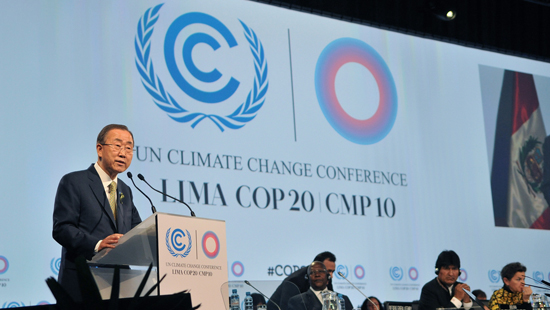It’s Time to View Climate Action for What It Is: A Historic Economic Opportunity
Edward Cameron
In recent days, I have struggled to form a settled view on COP20. Those looking to strike a positive note can legitimately point to an agreed text, forged by consensus across 196 countries, that provides a platform for further negotiations in 2015. Critics of the two-week climate talks can legitimately argue that long-standing disputes between countries remain unresolved, vital elements for holding global mean temperature rises below 2°C have been omitted, and an international climate deal with sufficient ambition remains in the balance.
On the positive front, negotiators made progress in setting goals to deepen the workstream of the negotiations dealing with pre-2020 ambition. This is already helping identify ambitious policy options and opportunities for multistakeholder collaboration that are outside the formal negotiations and open to a range of sectors including energy, transport, and agriculture. The decision in Lima to extend the mandate of this work holds promise for practical action in a manner that is truly open to business participation.
One promising initiative the Climate and Clean Air Coalition—coordinated by the United Nations Environment Programme and featuring more than 90 state and non-state partners—is encouraging action on short-lived climate pollutants such as methane, hydrofluorocarbons, and black carbon. Studies suggest that reduction of these pollutants can help slow global warming by up to 0.5°C between 2010 and 2050, thus contributing to reductions that will help us remain within the 2°C target in the near term.
Unfortunately, there are also many reasons to feel disappointed with the outcomes from Lima.
During the climate talks, my colleagues and I emphasized the need for the final text to create a pathway to “net zero” emissions well before the end of this century. In our view, this is essential to provide the forward-looking, stable, and long-term climate policies that business needs to unleash a wave of low-carbon innovation. Unfortunately, this text was cut from the final agreement. It is vital that net zero is included in the Paris agreement.
Going into the Lima talks, we expressed concern about the likely lack of ambition in national “contributions”—the greenhouse gas emissions reductions targets countries were likely to offer. To our dismay, the COP20 discussions reinforced this prediction. Too many countries signaled their intention to offer lowest-common-denominator contributions, and the final text emerging from Lima does not permit sufficient time, nor provide an adequate mechanism, to compel countries to increase their contributions.
For many years, two political issues have consistently undermined the prospects for agreement: the principles of “equity” and “Common but Differentiated Responsibilities and Respective Capabilities.” This is climate jargon for how governments share equally the burdens and opportunities of an early transition to a low-carbon future. Lima did little to resolve this long-standing dispute, and this will likely remain the primary point of contention in Paris.
More recently, this stalemate has been matched by an ongoing quarrel between developed and developing countries about climate finance. In 2010, developed countries committed to providing US$100 billion per year to support low-carbon development in developing countries. But there is little evidence to suggest that finance is being made available at the scale or in the form originally pledged, which has undermined confidence in the negotiations. The shortfall in public finance has increased the focus on private sector finance. As a result, private sector engagement is crucial to designing policies that truly catalyze private expertise, innovation, and products for climate finance.
One theme that emerged during the BSR Conference 2014 this November was that “good enough is no longer good enough” when it comes to creating true sustainability transformations.
Throughout this week, that thought has circled in my mind. “Good enough” must not be the benchmark of success that we use in 2015. The truth is, we can do better. To be on the right side of history, we must see bold climate action for what it is: not a burden, but a historic economic opportunity.

